How Much Right-Wing State Government Costs Us -- In Human Life
Conservatives often argue against proposals for public remedy on grounds of futility. Public remedy will be ineffectual, they say, because the problems it is meant to fix arise from intractable social conditions or human nature. When the new Speaker of the House Mike Johnson recently responded to demands for gun regulation after a mass shooting by saying that “at the end of the day” the true problem is not guns but the “human heart,” he was making the futility argument.
The “futility thesis,” as Albert Hirschman calls it in his classic The Rhetoric of Reaction, has a long history, but it has special relevance to contemporary politics. It played a major role in the neoconservative attack on liberal programs of the 1960s and subsequent rollback of federal regulation and spending. One of Ronald Reagan’s favorite lines, “We had a war on poverty, and poverty won,” perfectly expressed the conservative charge that liberal reform was futile. That view helped persuade Congress under Reagan and his successors not only to cut programs for low-income communities but also to devolve policy to the states through such measures as block grants that let the states decide how money would be spent.
More from Paul Starr
Although we hardly knew it at the time, the United States was conducting a national experiment: What would be the effect on Americans’ well-being if we turned over a wider array of policies to states controlled by political parties with opposed agendas? Three other developments have made state governments more central in policymaking. One is preemption. Since the 1980s, states in Republican hands have increasingly preempted local laws, preventing Democratic-run cities from adopting such policies as tobacco taxes and anti-smoking regulations, paid sick leave, and higher minimum wages.
The other two developments advancing the power of states are the work of the Supreme Court. By striking down the constitutional right to abortion, the Court has given states leeway to adopt diametrically opposed policies on reproductive rights. And by refusing to impose any limits on partisan gerrymandering, the Court has enabled incumbent state parties to expand their legislative majorities and entrench themselves in power.
These shifts have greatly increased both the importance of state-level policy and divergences between red and blue states. For many purposes, it no longer makes sense to think of the United States as one country. Depending on their state of residence, Americans live under drastically different policies concerning public health, taxes, the stinginess or generosity of public benefits, unionization, gun safety, and many other things that affect their well-being, indeed, their survival.
So what have been the results of the national experiment in putting more policymaking in the hands of states? Survival, as registered in mortality rates and life expectancy, is the ultimate measure of well-being, and the data for the United States in recent decades do not tell a happy story. While life expectancy continued rising in all the high-income countries in the late 20th century, the United States began lagging behind its peers. By 2006, it ranked last, and after 2014, life expectancy in this country began falling. The pattern, however, varies considerably across states.
As state-level policy has diverged since the 1970s (and especially since 2000), so have differences in mortality rates and life expectancy among the states. These differences are correlated with a state’s dominant political ideology. Americans’ chances of living longer are better if they live in a blue state and worse if they live in a red state. The differences by state particularly matter for low-income people, who are most likely to suffer the consequences of red states’ higher death rates. To be sure, correlation does not prove causation, and many different factors affect who lives and who dies. But a series of recent studies make a convincing case that the divergence of state-level policymaking on liberal-conservative lines has contributed significantly to the widening gap across states in life expectancy.
In a 2020 paper, a team of researchers led by Jennifer Karas Montez assembled annual data from 1970 through 2014 on both life expectancy and state policies in 18 different policy domains, including health, labor, the environment, and taxation. In previous work, one of the collaborating scholars, Jacob M. Grumbach, had shown that state-level policies over that period had polarized on a liberal-to-conservative spectrum. According to the new Montez study, which controlled for differences in state populations, the polarized shifts in state policy were associated with changes in life expectancy. States that adopted liberal policies were more likely to experience larger gains in life expectancy (and in recent years to avoid an outright decline). Connecticut and Oklahoma were the two states whose policies shifted the most, Connecticut toward the liberal side and Oklahoma toward the conservative side. In 1959, life expectancy in both states was 71.1 years; by 2017, it had increased to 80.7 years in Connecticut but only to 75.8 years in Oklahoma.
Couldn’t the explanation for such changes lie in changes in education, income, and other characteristics of the states? Montez and her co-authors estimated the association of life expectancy with state policy liberalism, net of other factors such as the composition of the state’s population. Taking those factors into account, their model indicated that if all states’ policies were the same as Connecticut’s in 2014, U.S. life expectancy would have been two years longer for women and 1.3 years longer for men—and if all states’ policies were like Oklahoma’s, Americans’ lives would have been shorter.
In a 2021 study, Benjamin K. Couillard and co-authors approached the question a different way, exploring alternative explanations for the increased geographic divergence in life expectancy. Much recent research on individual mortality rates has pointed to the increase in “deaths of despair” (drug overdoses, suicides, and alcohol-related disease), concentrated among Americans without a college degree. Might those deaths and the share of the college-educated population account for the increased divergence across states? The Couillard study found that it accounts for only about one-sixth of the change.
And what about changes in per capita income among the states? Perhaps life expectancy has fallen in states where incomes have fallen, while it has risen in states where incomes have gone up. It turns out, however, that changes in state incomes don’t predict changes in life expectancy. What does have an impact are differences in levels of state income over the preceding three decades. The longevity of a population today reflects the investments in health made in years past. The Couillard study concluded that “the most promising explanation” for rising geographic disparities lies in “efforts by high-income states to adopt specific health-improving policies and behaviors,” efforts which have “reduced mortality in high-income states more rapidly than in low-income states, leading to widening spatial disparities in health.” These efforts, they write, “include anti-smoking policies, expansions of Medicaid, income support, and norms around health behaviors.”
The full impact on life expectancy of a change in policy often takes years to emerge. For example, higher tobacco taxes may reduce smoking and deaths from lung cancer and other diseases, but mortality rates do not immediately register the effect. Similarly, much of the benefit from providing health care to children shows up only in adulthood. Untreated disease in children affects their energy and performance in school, onset of disabilities, adult health, and overall ability to thrive later in life.
In one of the rare studies that tracks long-term effects of policy, Andrew Goodman-Bacon used state-by-state variations in the original introduction of Medicaid coverage for children between 1966 and 1970 to estimate health and economic effects in adulthood. He found that early childhood eligibility for Medicaid reduced death and disability and increased employment up to 50 years later. In fact, it saved the government more than its original cost because the recipients later received less in public benefits and paid more in taxes.
Another recent study also makes a powerful case against the futility thesis. So many Americans already own guns that it may seem that no policy limiting firearms can make any difference. But in a paper published this year analyzing state-level changes in gun regulations and gun mortality from 1991 to 2016, Patrick Sharkey and Megan Kang found “strong, consistent evidence supporting the hypothesis that restrictive state gun policies reduce overall gun deaths,” including both homicides and suicides committed with guns. They used data on nine categories of gun laws to create an index for each state based on the balance between restrictive policies, such as background check requirements, and permissive policies, such as concealed-carry laws. For 2016 alone, they estimated that restrictive policies passed since 1991 averted 4,297 deaths, about 11 percent of the total gun deaths that year.
The shift of policymaking to the states is often justified on grounds of federalism and the belief that decisions should be left to the level of government closest to the people. But if conservatives genuinely believed in that principle, would they be agitating now for a national law to ban abortion? Would they be hoping that the Supreme Court continues to strike down state and local gun restrictions? Would they continue to support decisions by state legislatures to preempt local laws? What unites the right is not a principled belief in federalism or local control but a preference for making decisions at whatever level of government they dominate.
What also unites conservatives is a complete absence of any self-reflection about the impact of their policies on life and death in America. The futility thesis must be a great consolation to those who believe in it because otherwise they would have to confront the toll that their policies have taken. The balance of power in the states has been literally a life-and-death matter. Liberals and progressives should know that the policies they have struggled to enact have not been in vain.
Paul Starr is co-founder and co-editor of The American Prospect, professor of sociology and public affairs at Princeton University, and a winner of the Pulitzer Prize for general nonfiction and the Bancroft Prize in American history.
Reprinted with permission from The American Prospect.












